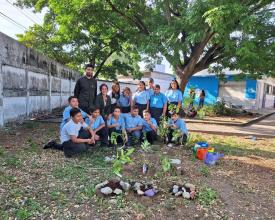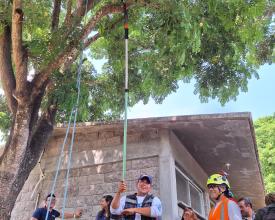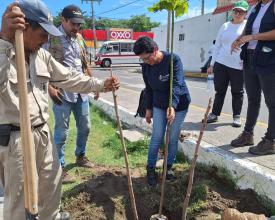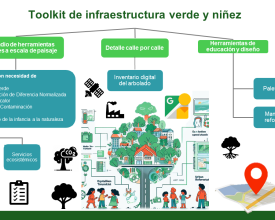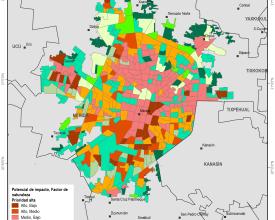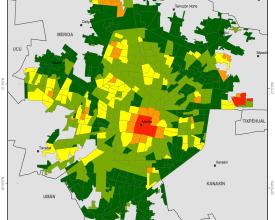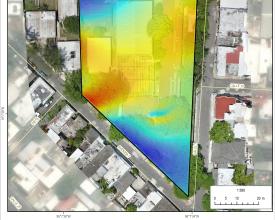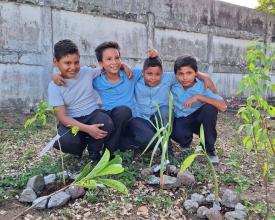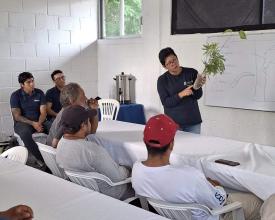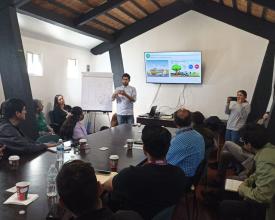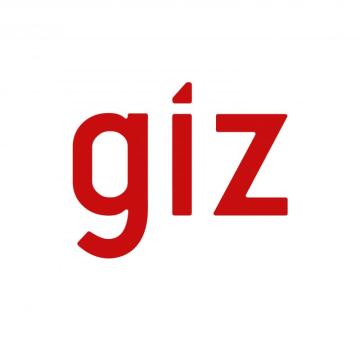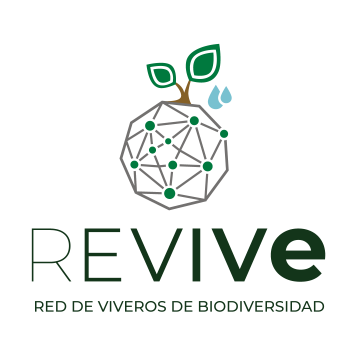
Cool cities are responsive cities: combining technology and biodiversity for climate change adaptation
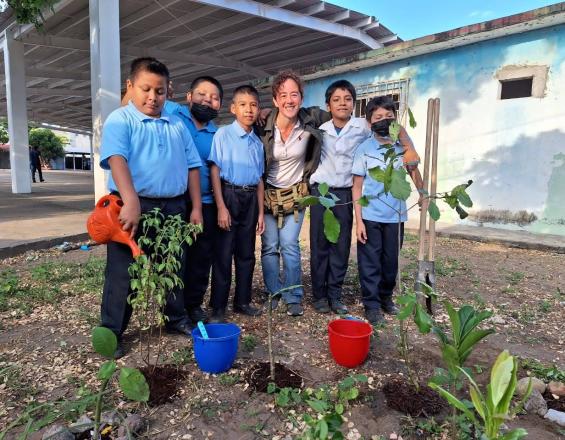
This solution is a subproject derived from the"Sembrando Ciudades" project, driven by GIZ, the Mexican government, private initiative and strategic partners, seeks to promote the climate resilience of coastal cities in the face of climate change. It uses innovative strategies, nature-based solutions and participatory processes that involve local communities and decision makers, focusing on vulnerable populations such as children, youth and women.
In this context, REVIVE focused on to strengthen local strategies and actions to conserve, improve and expand the green infrastructure of five coastal cities in Mexico. The objective was to generate information, strengthen technical capacities and develop a pilot of Nature-based Solutions (NBS) to improve public health, climate resilience and the economic profitability of the tourism, education and government sectors through the efficient management of urban trees.
Context
Challenges addressed
In Mexico, the coastal zone extends over 11,000 kilometers, distributed in 17 states and 265 municipalities, which generate 36% of the GDP and concentrate almost 40% of the national population. However, economic development and population growth in these areas have led to the exploitation and degradation of coastal ecosystems, such as mangroves, dunes, beaches and lagoons, which are fundamental for the local economy and the protection of the climate and biodiversity.
Accelerated urbanization and ineffective planning have intensified these problems, increasing the vulnerability of coastal cities to the effects of climate change, such as urban heat islands, water shortages, floods and droughts. In this context, children are especially vulnerable, facing significant risks to their health, safety and education due to the lack of safe and sustainable spaces to ensure their development and well-being.
Location
Process
Summary of the process
The generation of novel information on reforestation needs, maintenance and species selection for climate-smart greening, with a focus on the child population, guides informed and sustainable urban planning. This ensures that interventions are relevant and effective.
Environmental education and school reforestation activities not only raise children's awareness of the importance of natural environments in urban areas, but also promote safe and healthy spaces. These initiatives inspire new strategies among key stakeholders in the community, strengthening the commitment to sustainability.
Technical and operational capacity building of key stakeholders, through face-to-face and virtual workshops, is essential to effectively manage urban trees, which are crucial to support green infrastructure.
Communication and dissemination of results through local media and web platforms improve understanding of the project and increase its visibility, fostering collaboration and community support.
Successful implementation provides a replicable and scalable model for other cities.
Building Blocks
Green infrastructure and children toolkit: a tool for informed decision making on urban greening needs.
The objective of this phase was to generate a compendium of tools to guide informed decision making on urban reforestation needs in five Mexican coastal cities (Boca del Rio, Veracruz; Merida, Yucatan; San Mateo del Mar, Oaxaca; Tepic, Nayarit; Tijuana, Baja California).
- A compendium of landscape-scale tools was prepared with the products:
- Economic valuation of ecosystem services provided by urban trees.
- Normalized Difference Vegetation Index (NDVI) map.
- Green View Index Map (GVI)
- Fixed Pollution Sources Map (FFC)
- Children's Access to Nature Equity Index Map.
- Urban Heat Islands (UHI) Map.
The baseline for the efficient management of urban trees was elaborated through the street-by-street detail component of a high-resolution digital inventory, representative of the axes and road islands of each city. This inventory not only recorded the existing trees and their maintenance needs, but also identified plantable spaces, identified and catalogued the available plantable spaces, specifying the appropriate characteristics of each area, as well as the type of tree that can be planted in each site. This integrated approach ensures more accurate and sustainable planning, optimizing species selection and improving the health and biodiversity of the urban tree stock.
- In addition, educational and design tools were prepared. A practical guide for urban reforestation and two plant palettes for climate-smart reforestation were developed.
Enabling factors
- Availability of accurate geospatial and statistical data.
- Openness of local governments to receive and use the information.
- The tools and data provided complement current urban planning strategies.
Lesson learned
- Collaboration between various fields of study, such as ecology, urban planning and climate change, is crucial to address the complex challenges of urban reforestation in a comprehensive manner.
- It is important not only to identify problems, but also to propose concrete and viable solutions. Recommendations should be practical and focused on solving the challenges posed.
Inspiring pilots: school reforestation as a climate change adaptation measure
Once the areas with the greatest need for urban reforestation had been identified, schools with the potential to develop school reforestation interventions were selected. Subsequently, the project was shared with the corresponding Ministry of Education to verify the viability of the chosen schools. Thus, the Alfonso Arroyo Flores elementary school, located in the municipality of Boca del Río, was selected for this activity. A visit was made to the institute to present and socialize the initiative before the school authorities, ensuring their collaboration and support in the implementation of the reforestation activities.
The next step was the preparation of a diagnostic study of the intervention area to analyze soil fertility, complemented by a drone flight to generate the design of the interventions. This design, validated by the school community, was based on the Miyawaki Method, a high diversity and density afforestation approach that accelerates the development of vegetation and other ecological processes.
The implementation of the reforestation activities was divided into two stages. The first stage focused on environmental awareness and education. An explanation was given to the student community, including children, youth and teachers, about the importance of trees in urban environments and the principles of Miyawaki forests, as well as the critical points in the reforestation process. The language used was accessible and appropriate for the age group, promoting active participation to facilitate meaningful learning. In the second stage, the knowledge acquired during the previous stage was put into practice and the school reforestation was carried out together with the children.
This experience not only allowed for the tangible improvement of the green infrastructure, but also provided the opportunity to raise awareness among the students and allow them to experience the reforestation process in a sensory way.
Enabling factors
- The collaboration and support of the Ministry of Education and school authorities were fundamental to ensure the viability of the interventions.
- The active involvement of the school community, including students, teachers and parents, fostered a sense of ownership and responsibility for the project.
Lesson learned
- Consider the opinion of children as the main users and beneficiaries of the school space.
- Involving the entire school community from the beginning of the project increases the sense of ownership and responsibility towards green spaces.
- Using school reforestation as a pedagogical tool is essential to ensure the long-term sustainability of these projects. The practical activities of planting and caring for trees provide valuable lessons in ecology, sustainability and environmental responsibility.
Technical-operational training in the diagnosis and management of urban trees.
To strengthen the technical and operational capacities of key stakeholders in the management of urban trees and green areas, three face-to-face workshops and one virtual course were held. These events were aimed at local governments, academics, private companies, non-governmental organizations and members of civil society with the capacity and interest to influence decision-making on the urban landscape of each city benefiting from the project.
The main objective was to increase capacities in the diagnosis and management of urban trees, providing knowledge and essential tools for efficient and sustainable management of green infrastructure. The following topics were addressed in each face-to-face event, with variations according to the participants' level of knowledge:
- Presentation of the Sembrando Ciudades project
- Green Infrastructure and Children Toolkit, results for each city.
- Integrated Tree Management Plan.
- Macro and micro diagnosis.
- Inventories and censuses.
- Regulations.
- Zoning of greening needs.
- Intervention area, strategies and objectives.
- Selection of species and nursery plants.
- Community involvement.
- Pilots that inspire: execution of interventions.
- Critical steps in urban reforestation.
- Evaluation and measures of success.
- Air quality and its relationship with green infrastructure.
- Appraisal and management recommendations for urban trees.
The virtual course has the same objective as the workshops, so they complement and reinforce each other. However, in this event it focuses on:
- Calculate and economically value the ecosystem services provided by urban trees.
- Generate information to promote an informed urban management, through the identification and characterization of trees, as well as the identification of plantable spaces.
- Know the regulations, the entities involved in urban tree management, as well as funding opportunities and resources to promote reforestation in urban areas.
- Develop a comprehensive urban tree management plan to ensure the conservation and sustainable development of the urban environment.
Enabling factors
- The face-to-face workshops and the virtual course provided comprehensive and up-to-date training on multiple aspects of urban tree management in the cities benefiting from the project, which aroused great interest among the participants.
Lesson learned
- Regular workshops need to be scheduled to keep professionals and stakeholders involved in urban tree management up to date. Continuous training, especially of municipal government human resources, will ensure that staff are aware of the latest trends, practices and technologies related to sustainable urban tree management.
The integration of citizens, local government, civil society, academia and the private sector is essential to establish strong partnerships with the capacity to act efficiently in terms of financing, human and technical resources. In this sense, it is essential to promote spaces for periodic dialogue and meetings where all stakeholders can share knowledge, experiences and resources. In addition, it is important to establish formal cooperation and coordination mechanisms between these institutions to facilitate the implementation of joint projects.
Communication and dissemination of results
Dissemination and communication of the interventions took place through local press conferences organized by Colectivo Tomate as implementing partner, together with local governments, COMEX, GIZ and other strategic allies.
In addition, microsites were created on Google Sites that serve as hubs of accessible and updated information on the project. These microsites provide details of the interventions, methodologies employed, results obtained and next steps. They also offer educational resources such as guides and tools relevant to urban tree management and reforestation.
Enabling factors
- The backing of GIZ and the Mexican federal government as the project's promoters brought seriousness and relevance, which favored its acceptance.
- All stakeholders shared a common interest in urban sustainability and reforestation, which facilitated effective coordination and joint commitment.
The creation of microsites allowed for continuous dissemination of information about the project, accessible from anywhere and at any time.
Lesson learned
- Dissemination through local press conferences and collaboration with strategic partners proved effective in increasing the visibility and acceptance of the project.
- Microsites on Google Sites were effective tools for sharing detailed information during and after the project.
- The project experience highlighted the need to be open to continuous learning and adaptation of strategies according to local conditions and results.
- The successful implementation of the project provided a replicable and scalable model for other cities and communities interested in similar reforestation and sustainable urban tree management initiatives.
Impacts
Green Infrastructure and Children Toolkit
- 5 landscape-scale toolkits on reforestation needs.
- 5 high-resolution digital inventories of urban tree cover (4,000 ha).
- 2 plant palettes for climate-smart reforestation.
- 1 urban reforestation tutorial guide.
Inspiring pilots: school reforestation activities.
- Environmental awareness and reforestation activity with two school groups, 28 students (13 girls, 15 boys).
- 1 school reforested.
- 26 plants reforested in 3 Miyawaki groups.
Capacity building for key stakeholders
- 1 virtual course on diagnosis and management of urban trees.
- 3 face-to-face workshops to strengthen the capacities of key stakeholders in the diagnosis and management of urban tree plantations.
- 23 stakeholders trained virtually.
- 69 stakeholders trained in face-to-face workshops.
- 25 governmental, academic, private and civil society institutions trained.
Beneficiaries
- 5 cities have tools, information and technical capacity (local governments and relevant stakeholders) for climate-smart greening. Impact potential > 3,500,000 inhabitants.
- 1 school, 540 students (275 boys, 265 girls).


